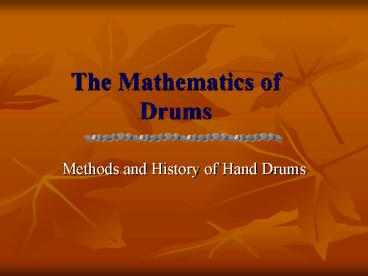The Mathematics of Drums - PowerPoint PPT Presentation
1 / 32
Title:
The Mathematics of Drums
Description:
The history of bongo drumming can be traced to the Cuban music styles known as Chang i and Son. ... Drums have been made for years and years. ... – PowerPoint PPT presentation
Number of Views:65
Avg rating:3.0/5.0
Title: The Mathematics of Drums
1
The Mathematics of Drums
- Methods and History of Hand Drums
2
The History of Drums
- First Known Drum 6000 BCE
- Found in Mesopotamia 3000 BCE
- Perhaps as far back as 5000BCE
3
Anatomy of a Drum
- The Parts
- Body
- Membrane
- Tuning Pegs/Strings
- Striking Object/Stick
4
(No Transcript)
5
Early Drums
- The first drums were used for communication
across great distances. - So-called Talking Drums can still be found in
many cultures (ex.Africa)
6
Talking drum from Ghana
7
Message Drums
- Another Style, called Message Drums or slit
gongs, evolved in Africa also.
8
Message Drums/Slit Gongs(W.Africa)
9
History of Bongos
- The history of bongo drumming can be traced to
the Cuban music styles known as Changüi and Son. - These styles first developed in eastern Cuba
(Oriente province) in the late 1800's around the
time that slavery was abolished.
10
Abakua
11
More History
- Initially, the bongo had heads which were tacked
and tuned with a heat source. - By the 1940s metal tuning lugs were developed to
facilitate easier tuning.
12
Typical Bongo
13
(No Transcript)
14
Types Drums by Shape
- Bongo
- Often confused w/Conga
- Can be Cylindrical or Waisted
- Conga
- Tapers to soft point at bottom
- Can be free-standing or attached.
- Cylindrical
- Most Common
- Used by Native Americans and in Antiquity
15
(No Transcript)
16
(No Transcript)
17
(No Transcript)
18
Shapes/Types
- Goblet
- Can be made from
- Gourds
- Carved Wood
- Waisted
- Like name suggest, nips in at center
19
(No Transcript)
20
Darabuka
21
Shapes/Types
- Bowl
- Also used in Antiquity
- Simplest Form
22
(No Transcript)
23
Other Distinctions
- May be double or single-headed
- May be handheld or in a stand
- Wide variety of styles and methods
24
Pitches and Tuning
- Tuning
- Strings
- Tightness of membrane
25
(No Transcript)
26
Mathematics and Drums
- Article Can you hear the shape of a Drum?
- Rebuttal You cant hear the shape of a Drum!
- Formulas/Proofs
27
Mathematics Involved in Drum Design
- The drums that we have discussed are all three
dimensional, enclosed spaces. Mathematically
modeling the flow of sound in a space such as
that is very tricky. It requires the mastering
of some very advanced techniques - partial differential equations
- numeric approximations for numeric solutions
28
Mathematics Involved in Drum Design
- When trying to calculate things like the
wavelengths and frequencies, and thus, the sound
produced by certain drums, it is much easier to
think of a one dimensional drum i.e. a
guitar string. - -With a string there are definite boundaries for
wavelength per cycle. Think of a guitar a wave
of sound is stretched out along the string,
starting with zero amplitude at one end at the
neck, and the wave rises and falls in amplitude
until it reaches the other end, which is also
zero. This allows for only a certain number of
definite possibilities for sounds produced. As
does the frequency of the sound produced because
it too has those common boundaries. The only
real variables involved are the strings tension
and their lengths.
29
Mathematics Involved in Drum Design
- A three dimensional drum, like the ones we have
discussed, do not have such definite boundaries.
Sound is produced by striking a plane, or the
drum head, and then it is resonated through the
cylinder on which it is stretched. - There are many different sounds produced by
hitting the same drum, with the same head at the
exact same tension, in different regions of the
plane. Every time you hit a drum on a different
spot, it theoretically has different boundaries. - Also, the sound produced relies on the length and
diameters of the cylinder as well as the type of
material it is made of
30
Mathematics Involved and Drum Design
- There are many more variables and components
involved when the shape changes from 1 to 3
dimensions. It gets much more complicated and
requires much more abstract and advanced
techniques than I know, for sure. - The sound advice I have gathered is trial and
error. Drums have been made for years and years.
There are certain shapes and dimensions that
produce the desired sound and some that do not.
You just have to study up on what drums make what
sounds and then construct and design using them
as models.
31
Links and Bibliography
- http//www.wikepedia.org
- http//www.percussiveartssociety.org
- http//www.wisegeek.com
- http//www.googleimages.com
32
Conclusion
- Which came first
- The Drums or The Math?































